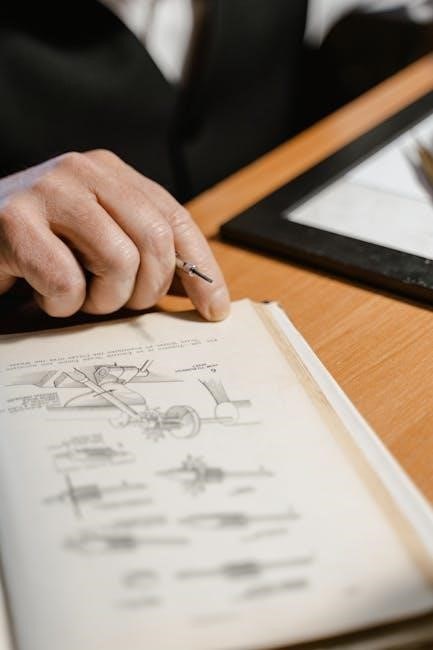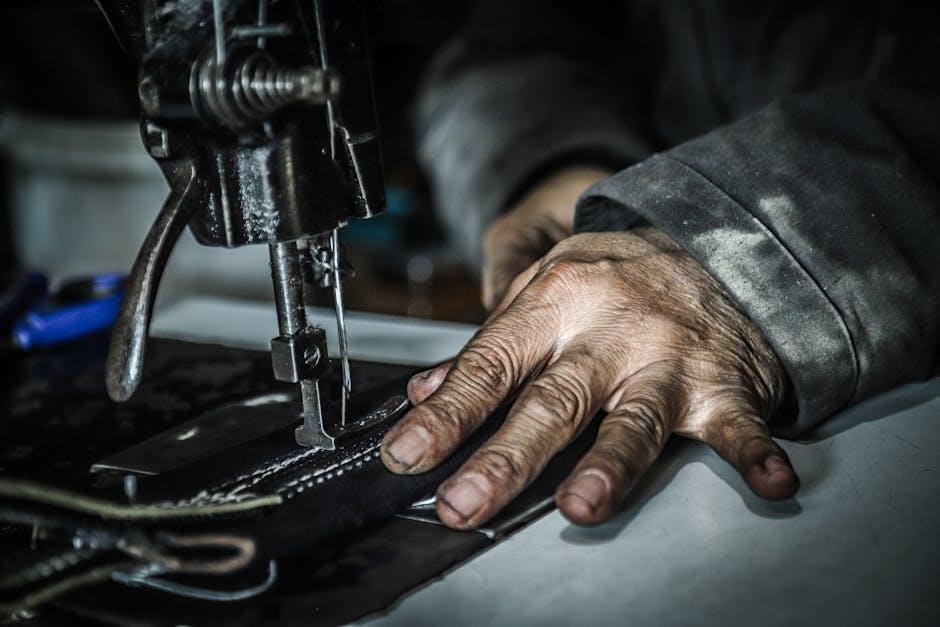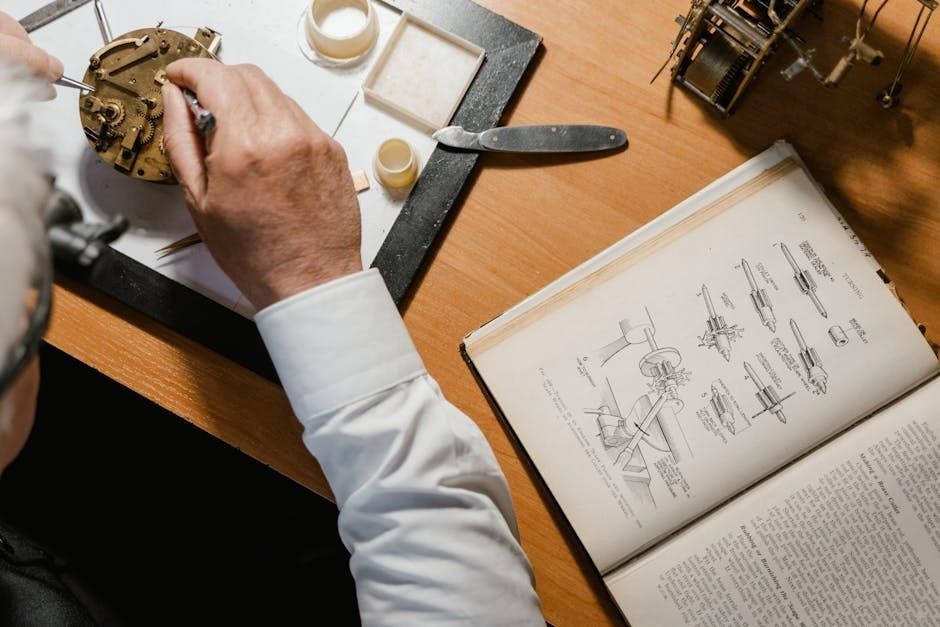
Singer Sew Mate 5400 Instruction Manual: A Comprehensive Guide
Welcome! This guide provides a detailed overview of the Singer Sew Mate 5400 sewing machine․ You’ll find information on accessing the user manual, threading, troubleshooting, needle and tension adjustments, maintenance, and available accessories․ Let’s explore how to use your sewing machine effectively!
Overview of the Singer Sew Mate 5400
The Singer Sew Mate 5400 is an automatic sewing machine designed with ease-of-use features, perfect for both beginners and experienced sewers․ It offers a variety of stitches and settings, allowing for diverse sewing projects․ This machine simplifies the sewing process with optimum stitch length and width settings selected automatically when you choose a stitch․
This model is known for its reliability and user-friendly design․ It is part of the Singer 5400 series, recognized for its straightforward operation and comprehensive functionality․ The Sew Mate 5400 is equipped to handle a range of fabrics and sewing tasks, making it a versatile addition to any sewing room․
The Singer Sew Mate 5400 boasts features that streamline the sewing experience, ensuring efficiency and precision․ Its automatic capabilities reduce the learning curve, enabling users to quickly start and complete their projects․ With its robust construction and intuitive controls, the Sew Mate 5400 provides a seamless sewing journey for all skill levels․
Accessing the User Manual
The user manual for the Singer Sew Mate 5400 is an invaluable resource, providing detailed instructions and guidance for operating your sewing machine․ If you’ve misplaced your original manual, don’t worry! Accessing a digital copy is easy and convenient․ Many resources offer free downloads of the Singer Sew Mate 5400 manual․
Websites like ManualsLib and the official Singer website often host PDF versions of the manual․ Simply search for “Singer Sew Mate 5400 user manual” on these sites to find and download the document․ These manuals are usually available for free, ensuring you have the necessary information at your fingertips․
The user manual includes essential information on threading, stitch selection, troubleshooting, and maintenance․ It also contains diagrams and illustrations to help you understand each step․ Having the manual readily available will enhance your sewing experience and help you resolve any issues that may arise․ Keep it handy for quick reference!
Threading the Singer Sew Mate 5400
Threading your Singer Sew Mate 5400 correctly is crucial for smooth sewing․ Start by placing the spool of thread on the spool pin․ Guide the thread through the upper thread guides, following the numbered diagram on the machine․ Make sure the thread is securely seated in each guide to maintain consistent tension․
Next, thread the machine’s tension discs by wrapping the thread around them․ This ensures proper thread control during sewing․ Bring the thread down to the needle area and thread the needle from front to back․ Some models have an automatic needle threader; consult your manual for instructions if yours does․

Finally, draw the bobbin thread up through the needle plate․ Hold both the needle thread and bobbin thread together, and place them under the presser foot․ Test the threading by sewing a few stitches on a scrap of fabric to ensure everything is correctly aligned and the tension is balanced․ Correct threading prevents skipped stitches!
Troubleshooting Common Issues
Encountering problems with your Singer Sew Mate 5400 is frustrating, but many issues have simple solutions․ If the machine is not feeding fabric, check that the feed dogs are raised and not covered by a plate․ Ensure the presser foot is lowered, providing necessary pressure for the fabric to move;
For thread breakage, verify the machine is threaded correctly, and the thread isn’t old or damaged․ Replace the needle with a new one, ensuring it’s the correct size and type for your fabric․ Uneven stitches often result from incorrect tension settings․ Adjust the upper thread tension dial to achieve balanced stitches;
If the bobbin winder isn’t working, confirm the bobbin is correctly placed on the bobbin winder spindle and the spindle is engaged․ Make sure the machine’s power switch is on and the foot pedal is correctly connected․ Regularly clean lint and debris from the bobbin area to prevent jams and ensure smooth operation․
Needle Issues and Solutions
Needle problems are a frequent cause of sewing machine malfunctions․ A bent or blunt needle can skip stitches, break thread, or damage fabric․ Always inspect the needle before starting a project and replace it if it shows any signs of wear or damage․
Ensure the needle is correctly inserted, with the flat side facing the rear for most modern machines․ Using the wrong type of needle for your fabric can also cause issues․ Finer fabrics require a sharp, fine needle, while heavier fabrics need a stronger, larger needle․

If the needle repeatedly breaks, check the needle size and thread compatibility․ Thick threads used with a small needle can cause excessive friction and breakage․ Make sure the needle is securely fastened and not loose, as this can also lead to breakage․ Lastly, verify the needle is not hitting the needle plate or presser foot․
Tension Adjustment
Proper tension is crucial for achieving balanced and neat stitches․ The upper and lower thread tensions must be correctly balanced to create a secure stitch where the threads interlock in the middle of the fabric․ Uneven tension can lead to loose stitches, thread breakage, or puckering of the fabric․
To adjust the upper thread tension, locate the tension dial on your Singer Sew Mate 5400․ Increase the tension if the bobbin thread is visible on the top side of the fabric․ Decrease the tension if the upper thread is visible on the underside․ Make small adjustments and test on a scrap fabric until the stitches appear balanced․
If adjusting the upper thread tension doesn’t resolve the issue, check the bobbin tension․ A too-tight or too-loose bobbin tension can disrupt the balance․ Refer to your user manual for instructions on adjusting the bobbin tension, as it varies depending on the bobbin type․
Service and Maintenance
Regular service and maintenance are essential to keep your Singer Sew Mate 5400 operating smoothly and extend its lifespan․ Before any maintenance, always unplug the machine to prevent accidental starts․
Cleaning is the most important maintenance task․ Remove the needle plate and clean out lint and thread buildup from the feed dogs and bobbin area using a small brush or lint brush․ A build-up of debris can affect the machine’s performance․

Oiling is also important, but only oil parts specified in the user manual․ Use sewing machine oil and apply sparingly․ Over-oiling can attract dust and lint․ Consult the manual to determine the oiling points and frequency․
Periodically check the needle and replace it if it’s bent, blunt, or damaged․ Also, inspect the machine for loose screws or parts․ Tighten them as needed․ If you encounter complex issues or need extensive repairs, consult a qualified sewing machine technician․
Available Accessories and Parts
The Singer Sew Mate 5400 comes with a variety of accessories to enhance your sewing experience․ These may include different presser feet (such as a general-purpose foot, zipper foot, buttonhole foot), bobbins, needles, a seam ripper, and a screwdriver․ The exact accessories included can vary, so refer to your machine’s packaging or user manual for a complete list․
Additional accessories and replacement parts are also available for purchase․ These can include specialty presser feet for tasks like quilting, hemming, or decorative stitching․ You can find replacement needles, bobbins, and other consumable parts as well․
When purchasing accessories or parts, make sure they are compatible with the Singer Sew Mate 5400․ Using the correct parts will ensure proper machine operation and prevent damage․ Check the Singer website or authorized retailers for genuine Singer accessories and parts․
Finding Service Manuals
A service manual is a crucial resource for in-depth maintenance, troubleshooting, and repair of your Singer Sew Mate 5400․ Unlike the user manual, which focuses on basic operation, the service manual provides detailed instructions for disassembling, adjusting, and reassembling the machine․
Finding a service manual for the Singer Sew Mate 5400 can sometimes be challenging․ Start by checking the Singer website or contacting Singer customer support․ They may have a digital version available for download or be able to direct you to a reputable source․
Online forums and sewing machine repair websites can also be valuable resources․ Other users may have shared service manuals or be able to offer guidance on where to find one․ Be cautious when downloading files from unofficial sources, and ensure the file is safe before opening it․

Leave a Reply
You must be logged in to post a comment.